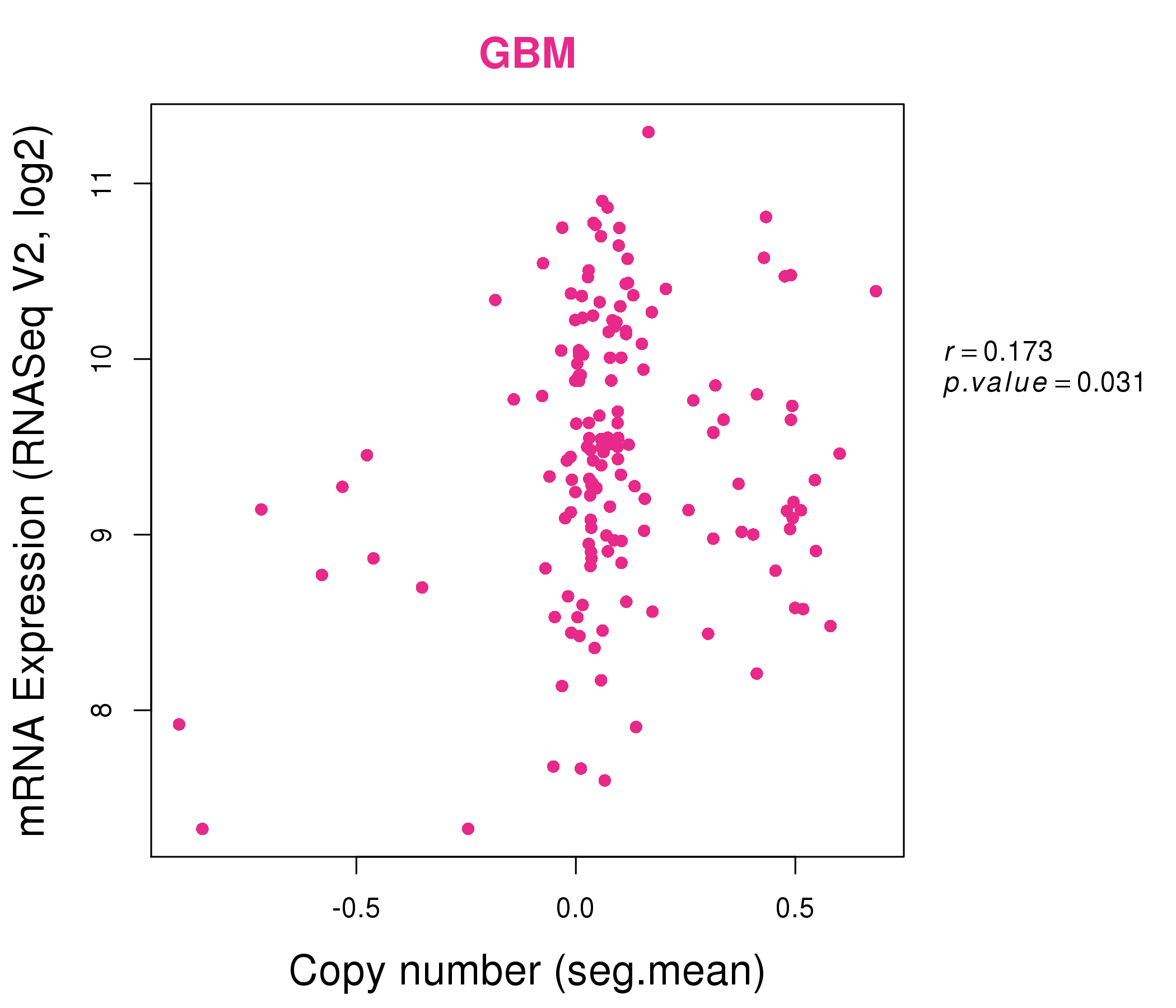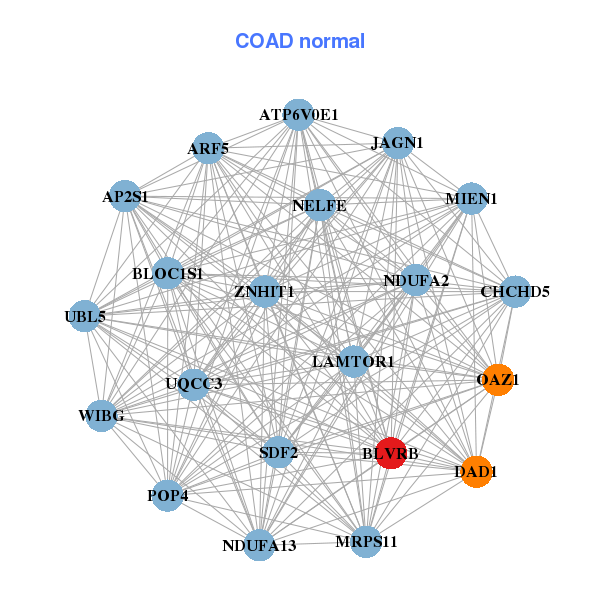|
||||||||||||||||||||||||||||||||||||||||||||||||||||||||||||||||||||||||||||||||||||||||||||||||||||||||||||||||||||||||||||||||||||||||||||||||||||||||||||||||||||||||||||||||||||||||||||||||||||||||||||||||||||||||||||||||||||||||||||||||||||||||||||||||||||||||||||||||||||||||||||||||||||||||||||||||||||||||||||||||||||||||||||||||||||||||||||||||||||||||||||||||||||
| |
| Phenotypic Information (metabolism pathway, cancer, disease, phenome) |
| |
| |
| Gene-Gene Network Information: Co-Expression Network, Interacting Genes & KEGG |
| |
|
| Gene Summary for BLVRB |
| Basic gene info. | Gene symbol | BLVRB |
| Gene name | biliverdin reductase B | |
| Synonyms | BVRB|FLR|HEL-S-10|SDR43U1 | |
| Cytomap | UCSC genome browser: 19q13.1-q13.2 | |
| Genomic location | chr19 :40953690-40971725 | |
| Type of gene | protein-coding | |
| RefGenes | NM_000713.2, | |
| Ensembl id | ENSG00000090013 | |
| Description | BVR-BFRGHBPNADPH-dependent diaphoraseNADPH-flavin reductasebiliverdin reductase B (flavin reductase (NADPH))biliverdin-IX beta-reductaseepididymis secretory protein Li 10flavin reductase (NADPH)green heme-binding proteinshort chain dehydrogenase | |
| Modification date | 20141207 | |
| dbXrefs | MIM : 600941 | |
| HGNC : HGNC | ||
| Ensembl : ENSG00000090013 | ||
| HPRD : 02967 | ||
| Vega : OTTHUMG00000182593 | ||
| Protein | UniProt: go to UniProt's Cross Reference DB Table | |
| Expression | CleanEX: HS_BLVRB | |
| BioGPS: 645 | ||
| Gene Expression Atlas: ENSG00000090013 | ||
| The Human Protein Atlas: ENSG00000090013 | ||
| Pathway | NCI Pathway Interaction Database: BLVRB | |
| KEGG: BLVRB | ||
| REACTOME: BLVRB | ||
| ConsensusPathDB | ||
| Pathway Commons: BLVRB | ||
| Metabolism | MetaCyc: BLVRB | |
| HUMANCyc: BLVRB | ||
| Regulation | Ensembl's Regulation: ENSG00000090013 | |
| miRBase: chr19 :40,953,690-40,971,725 | ||
| TargetScan: NM_000713 | ||
| cisRED: ENSG00000090013 | ||
| Context | iHOP: BLVRB | |
| cancer metabolism search in PubMed: BLVRB | ||
| UCL Cancer Institute: BLVRB | ||
| Assigned class in ccmGDB | C | |
| Top |
| Phenotypic Information for BLVRB(metabolism pathway, cancer, disease, phenome) |
| Cancer | CGAP: BLVRB |
| Familial Cancer Database: BLVRB | |
| * This gene is included in those cancer gene databases. |
|
|
|
|
|
|
| ||||||||||||||||||||||||||||||||||||||||||||||||||||||||||||||||||||||||||||||||||||||||||||||||||||||||||||||||||||||||||||||||||||||||||||||||||||||||||||||||||||||||||||||||||||||||||||||||||||||||||||||||||||||||||||||||||||||||||||||||||||||||||||||||||||||||||||||||||||||||||||||||||||||||||||||||||||||||||||||||||||||||||||||||||||||||||||||||||||||||||||||
Oncogene 1 | Significant driver gene in | |||||||||||||||||||||||||||||||||||||||||||||||||||||||||||||||||||||||||||||||||||||||||||||||||||||||||||||||||||||||||||||||||||||||||||||||||||||||||||||||||||||||||||||||||||||||||||||||||||||||||||||||||||||||||||||||||||||||||||||||||||||||||||||||||||||||||||||||||||||||||||||||||||||||||||||||||||||||||||||||||||||||||||||||||||||||||||||||||||||||||||||||||||
| cf) number; DB name 1 Oncogene; http://nar.oxfordjournals.org/content/35/suppl_1/D721.long, 2 Tumor Suppressor gene; https://bioinfo.uth.edu/TSGene/, 3 Cancer Gene Census; http://www.nature.com/nrc/journal/v4/n3/abs/nrc1299.html, 4 CancerGenes; http://nar.oxfordjournals.org/content/35/suppl_1/D721.long, 5 Network of Cancer Gene; http://ncg.kcl.ac.uk/index.php, 1Therapeutic Vulnerabilities in Cancer; http://cbio.mskcc.org/cancergenomics/statius/ |
| KEGG_PORPHYRIN_AND_CHLOROPHYLL_METABOLISM REACTOME_METABOLISM_OF_PORPHYRINS | |
| OMIM | |
| Orphanet | |
| Disease | KEGG Disease: BLVRB |
| MedGen: BLVRB (Human Medical Genetics with Condition) | |
| ClinVar: BLVRB | |
| Phenotype | MGI: BLVRB (International Mouse Phenotyping Consortium) |
| PhenomicDB: BLVRB | |
| Mutations for BLVRB |
| * Under tables are showing count per each tissue to give us broad intuition about tissue specific mutation patterns.You can go to the detailed page for each mutation database's web site. |
| - Statistics for Tissue and Mutation type | Top |
 |
| - For Inter-chromosomal Variations |
| There's no inter-chromosomal structural variation. |
| - For Intra-chromosomal Variations |
| * Intra-chromosomal variantions includes 'intrachromosomal amplicon to amplicon', 'intrachromosomal amplicon to non-amplified dna', 'intrachromosomal deletion', 'intrachromosomal fold-back inversion', 'intrachromosomal inversion', 'intrachromosomal tandem duplication', 'Intrachromosomal unknown type', 'intrachromosomal with inverted orientation', 'intrachromosomal with non-inverted orientation'. |
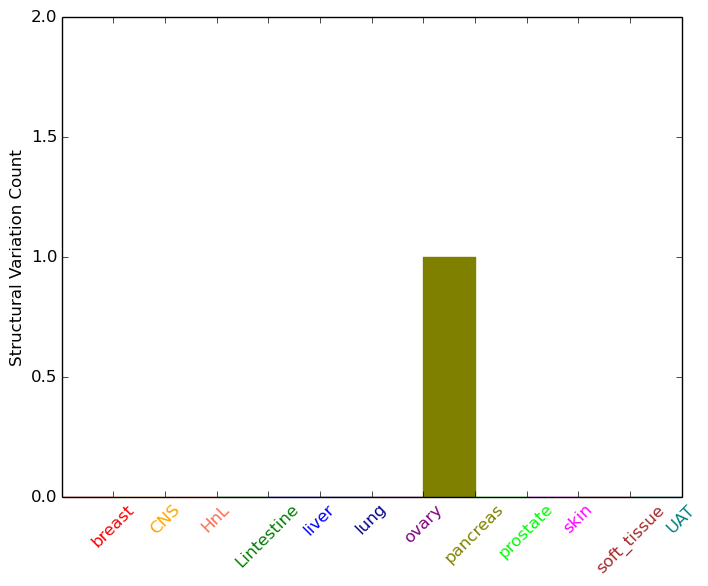 |
| Sample | Symbol_a | Chr_a | Start_a | End_a | Symbol_b | Chr_b | Start_b | End_b |
| pancreas | BLVRB | chr19 | 40963590 | 40963610 | BLVRB | chr19 | 40964639 | 40964659 |
| cf) Tissue number; Tissue name (1;Breast, 2;Central_nervous_system, 3;Haematopoietic_and_lymphoid_tissue, 4;Large_intestine, 5;Liver, 6;Lung, 7;Ovary, 8;Pancreas, 9;Prostate, 10;Skin, 11;Soft_tissue, 12;Upper_aerodigestive_tract) |
| * From mRNA Sanger sequences, Chitars2.0 arranged chimeric transcripts. This table shows BLVRB related fusion information. |
| ID | Head Gene | Tail Gene | Accession | Gene_a | qStart_a | qEnd_a | Chromosome_a | tStart_a | tEnd_a | Gene_a | qStart_a | qEnd_a | Chromosome_a | tStart_a | tEnd_a |
| Top |
| Mutation type/ Tissue ID | brca | cns | cerv | endome | haematopo | kidn | Lintest | liver | lung | ns | ovary | pancre | prost | skin | stoma | thyro | urina | |||
| Total # sample | 1 | |||||||||||||||||||
| GAIN (# sample) | 1 | |||||||||||||||||||
| LOSS (# sample) |
| cf) Tissue ID; Tissue type (1; Breast, 2; Central_nervous_system, 3; Cervix, 4; Endometrium, 5; Haematopoietic_and_lymphoid_tissue, 6; Kidney, 7; Large_intestine, 8; Liver, 9; Lung, 10; NS, 11; Ovary, 12; Pancreas, 13; Prostate, 14; Skin, 15; Stomach, 16; Thyroid, 17; Urinary_tract) |
| Top |
|
 |
| Top |
| Stat. for Non-Synonymous SNVs (# total SNVs=4) | (# total SNVs=6) |
 | 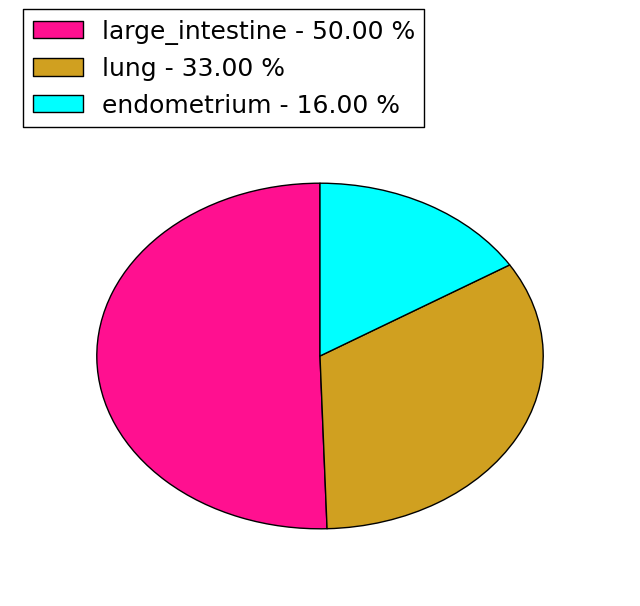 |
(# total SNVs=0) | (# total SNVs=0) |
| Top |
| * When you move the cursor on each content, you can see more deailed mutation information on the Tooltip. Those are primary_site,primary_histology,mutation(aa),pubmedID. |
| GRCh37 position | Mutation(aa) | Unique sampleID count |
| chr19:40953835-40953835 | p.Y194Y | 2 |
| chr19:40957392-40957392 | p.L114L | 1 |
| chr19:40964105-40964105 | p.A97A | 1 |
| chr19:40964286-40964286 | p.? | 1 |
| chr19:40964289-40964289 | p.L81L | 1 |
| chr19:40964325-40964325 | p.D69D | 1 |
| chr19:40953837-40953837 | p.Y194H | 1 |
| chr19:40964360-40964360 | p.A58T | 1 |
| chr19:40953902-40953902 | p.P172L | 1 |
| chr19:40957295-40957295 | p.V147M | 1 |
| Top |
|
 |
| Point Mutation/ Tissue ID | 1 | 2 | 3 | 4 | 5 | 6 | 7 | 8 | 9 | 10 | 11 | 12 | 13 | 14 | 15 | 16 | 17 | 18 | 19 | 20 |
| # sample | 1 | 4 | 1 | 1 | 1 | 1 | 1 | |||||||||||||
| # mutation | 1 | 4 | 1 | 1 | 1 | 1 | 1 | |||||||||||||
| nonsynonymous SNV | 1 | 2 | 1 | 1 | ||||||||||||||||
| synonymous SNV | 2 | 1 | 1 | 1 |
| cf) Tissue ID; Tissue type (1; BLCA[Bladder Urothelial Carcinoma], 2; BRCA[Breast invasive carcinoma], 3; CESC[Cervical squamous cell carcinoma and endocervical adenocarcinoma], 4; COAD[Colon adenocarcinoma], 5; GBM[Glioblastoma multiforme], 6; Glioma Low Grade, 7; HNSC[Head and Neck squamous cell carcinoma], 8; KICH[Kidney Chromophobe], 9; KIRC[Kidney renal clear cell carcinoma], 10; KIRP[Kidney renal papillary cell carcinoma], 11; LAML[Acute Myeloid Leukemia], 12; LUAD[Lung adenocarcinoma], 13; LUSC[Lung squamous cell carcinoma], 14; OV[Ovarian serous cystadenocarcinoma ], 15; PAAD[Pancreatic adenocarcinoma], 16; PRAD[Prostate adenocarcinoma], 17; SKCM[Skin Cutaneous Melanoma], 18:STAD[Stomach adenocarcinoma], 19:THCA[Thyroid carcinoma], 20:UCEC[Uterine Corpus Endometrial Carcinoma]) |
| Top |
| * We represented just top 10 SNVs. When you move the cursor on each content, you can see more deailed mutation information on the Tooltip. Those are primary_site, primary_histology, mutation(aa), pubmedID. |
| Genomic Position | Mutation(aa) | Unique sampleID count |
| chr19:40953835 | p.Y194Y | 2 |
| chr19:40964360 | p.P172H | 1 |
| chr19:40971542 | p.R134W | 1 |
| chr19:40953902 | p.D131N | 1 |
| chr19:40957334 | p.A127S | 1 |
| chr19:40957343 | p.L114L | 1 |
| chr19:40957355 | p.L81L | 1 |
| chr19:40957392 | p.A58T | 1 |
| chr19:40964289 | p.T18T | 1 |
| * Copy number data were extracted from TCGA using R package TCGA-Assembler. The URLs of all public data files on TCGA DCC data server were gathered on Jan-05-2015. Function ProcessCNAData in TCGA-Assembler package was used to obtain gene-level copy number value which is calculated as the average copy number of the genomic region of a gene. |
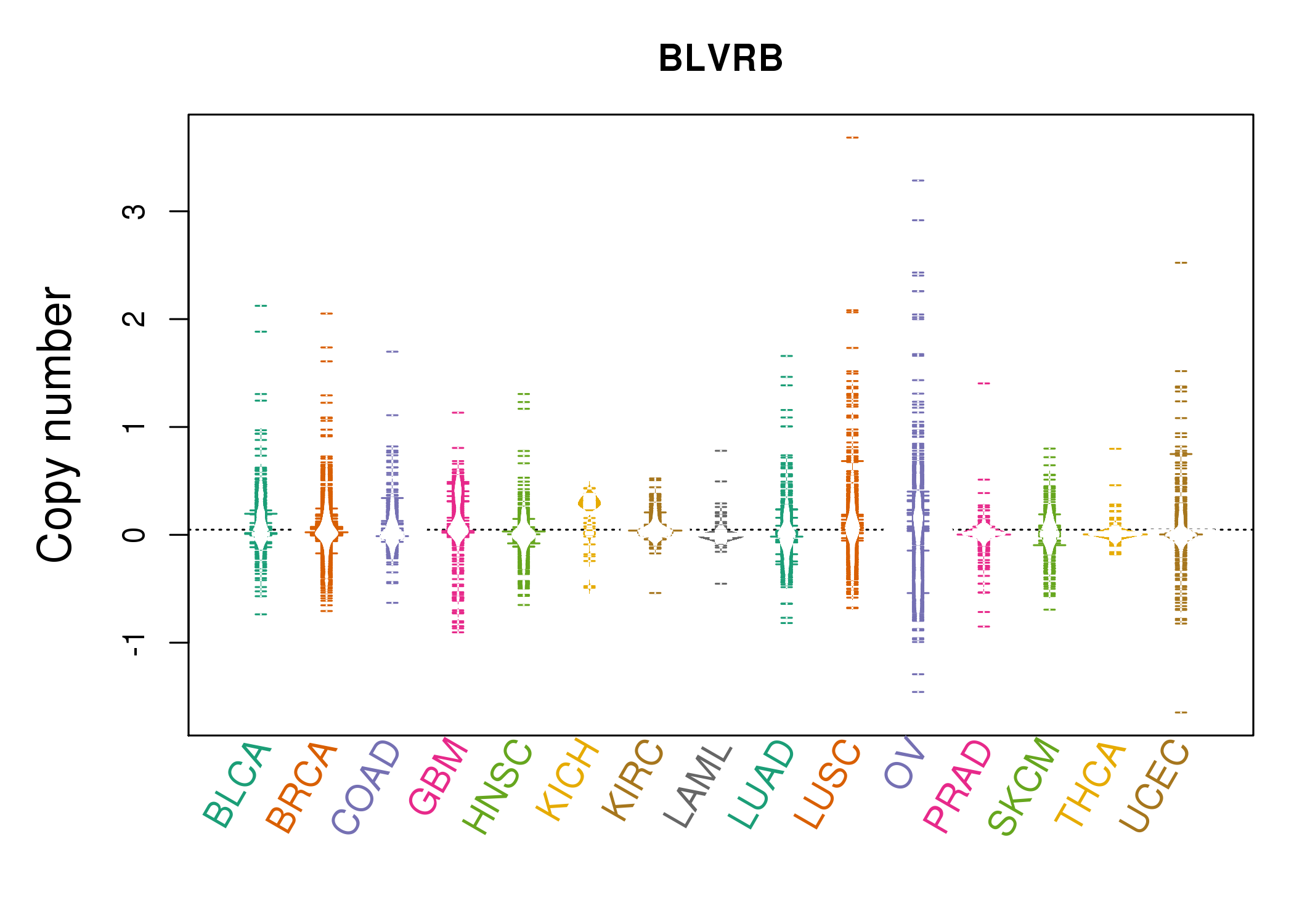 |
| cf) Tissue ID[Tissue type]: BLCA[Bladder Urothelial Carcinoma], BRCA[Breast invasive carcinoma], CESC[Cervical squamous cell carcinoma and endocervical adenocarcinoma], COAD[Colon adenocarcinoma], GBM[Glioblastoma multiforme], Glioma Low Grade, HNSC[Head and Neck squamous cell carcinoma], KICH[Kidney Chromophobe], KIRC[Kidney renal clear cell carcinoma], KIRP[Kidney renal papillary cell carcinoma], LAML[Acute Myeloid Leukemia], LUAD[Lung adenocarcinoma], LUSC[Lung squamous cell carcinoma], OV[Ovarian serous cystadenocarcinoma ], PAAD[Pancreatic adenocarcinoma], PRAD[Prostate adenocarcinoma], SKCM[Skin Cutaneous Melanoma], STAD[Stomach adenocarcinoma], THCA[Thyroid carcinoma], UCEC[Uterine Corpus Endometrial Carcinoma] |
| Top |
| Gene Expression for BLVRB |
| * CCLE gene expression data were extracted from CCLE_Expression_Entrez_2012-10-18.res: Gene-centric RMA-normalized mRNA expression data. |
 |
| * Normalized gene expression data of RNASeqV2 was extracted from TCGA using R package TCGA-Assembler. The URLs of all public data files on TCGA DCC data server were gathered at Jan-05-2015. Only eight cancer types have enough normal control samples for differential expression analysis. (t test, adjusted p<0.05 (using Benjamini-Hochberg FDR)) |
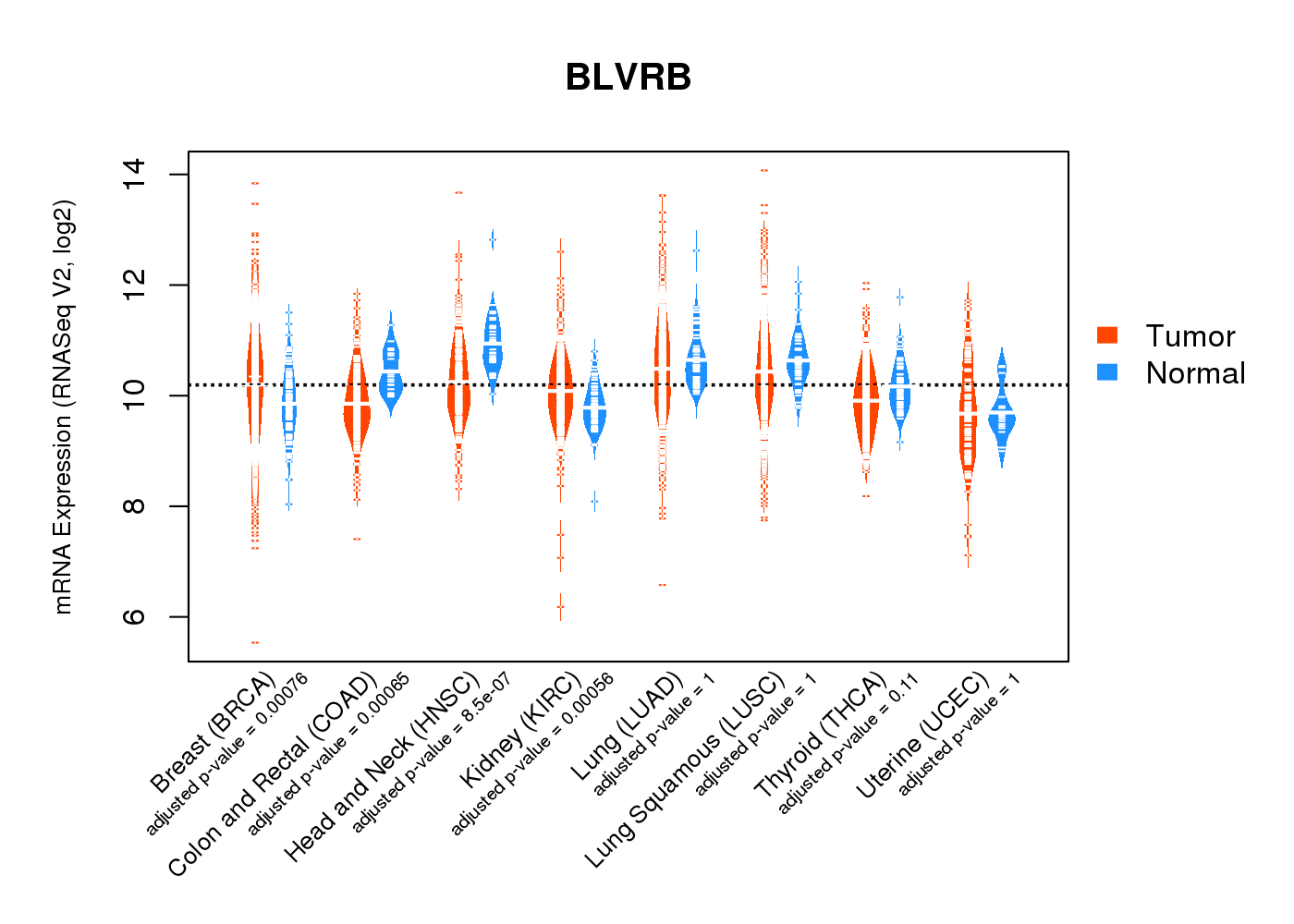 |
| Top |
| * This plots show the correlation between CNV and gene expression. |
: Open all plots for all cancer types
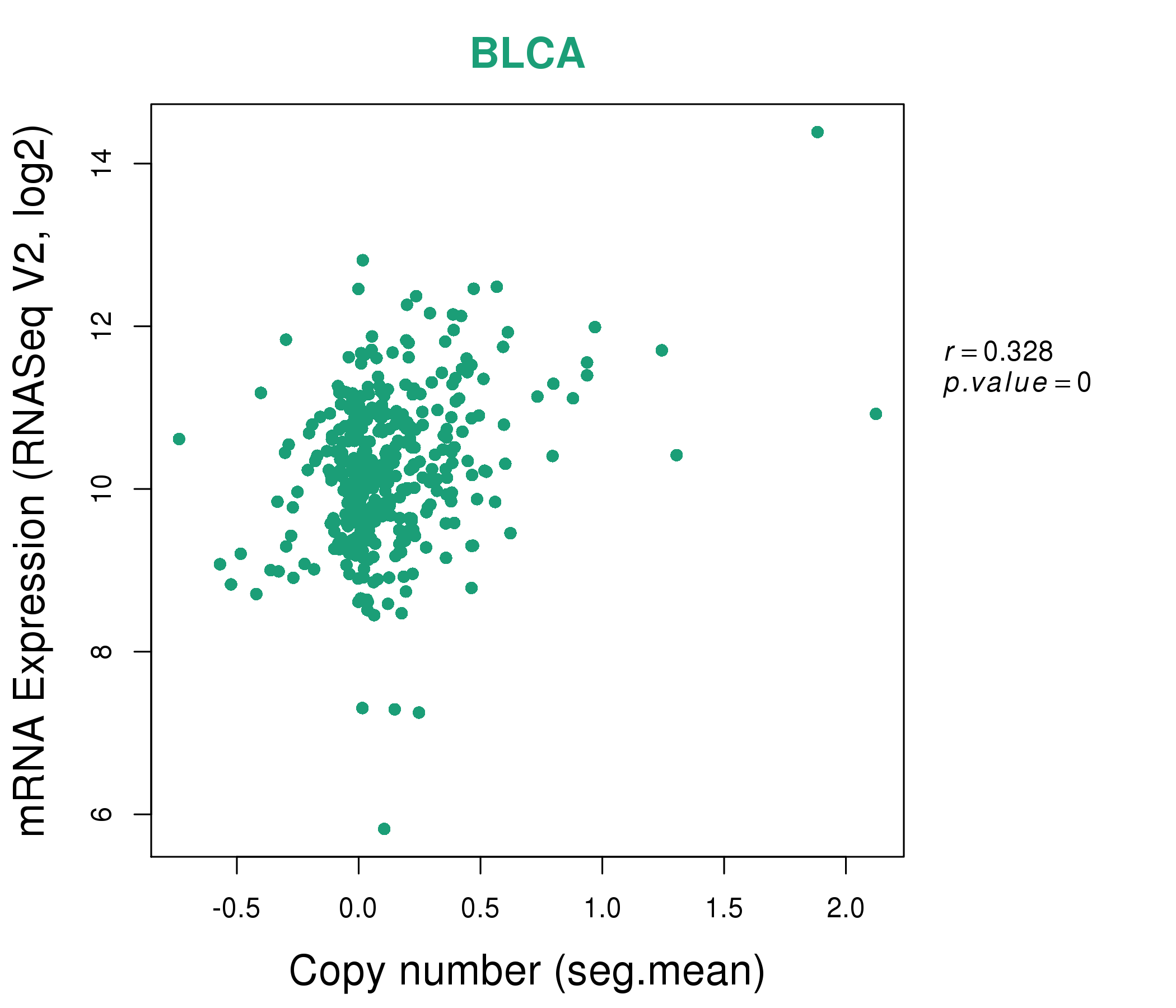 |
|
 |
|
| Top |
| Gene-Gene Network Information |
| * Co-Expression network figures were drawn using R package igraph. Only the top 20 genes with the highest correlations were shown. Red circle: input gene, orange circle: cell metabolism gene, sky circle: other gene |
: Open all plots for all cancer types
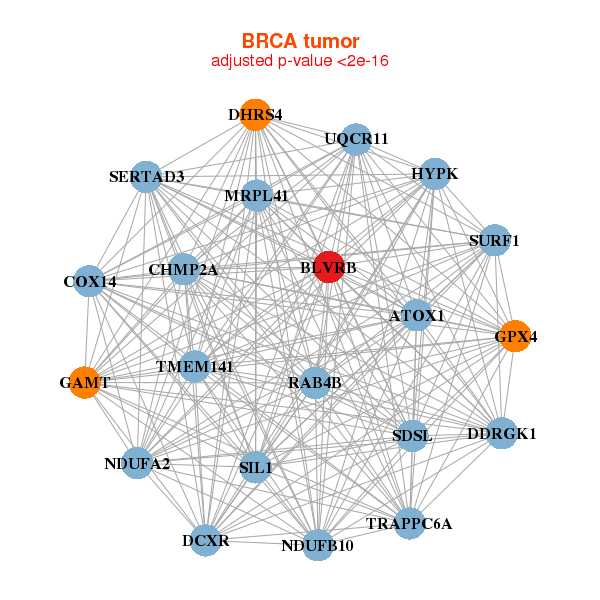 |
| ||||
| ATOX1,BLVRB,COX14,HYPK,CHMP2A,DCXR,DDRGK1, DHRS4,GAMT,GPX4,MRPL41,NDUFA2,NDUFB10,RAB4B, SDSL,SERTAD3,SIL1,SURF1,TMEM141,TRAPPC6A,UQCR11 | ARL2,ASCC2,BLOC1S1,BLVRB,CNPPD1,CCM2,CD63, FAM50A,IFI27L1,LOC729991,MRPS11,NAGLU,NUCB1,OAZ1, POLD4,POLR2L,RNH1,RNPEPL1,SMPD1,UROD,USF2 | ||||
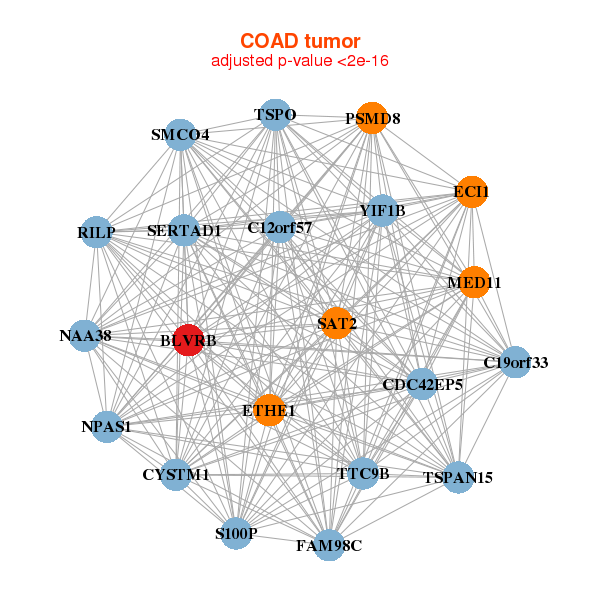 |
| ||||
| BLVRB,SMCO4,C12orf57,C19orf33,CYSTM1,CDC42EP5,ECI1, ETHE1,FAM98C,NAA38,MED11,NPAS1,PSMD8,RILP, S100P,SAT2,SERTAD1,TSPAN15,TSPO,TTC9B,YIF1B | AP2S1,ARF5,ATP6V0E1,BLOC1S1,BLVRB,LAMTOR1,UQCC3, MIEN1,CHCHD5,DAD1,JAGN1,MRPS11,NDUFA13,NDUFA2, OAZ1,POP4,NELFE,SDF2,UBL5,WIBG,ZNHIT1 |
| * Co-Expression network figures were drawn using R package igraph. Only the top 20 genes with the highest correlations were shown. Red circle: input gene, orange circle: cell metabolism gene, sky circle: other gene |
: Open all plots for all cancer types
| Top |
: Open all interacting genes' information including KEGG pathway for all interacting genes from DAVID
| Top |
| Pharmacological Information for BLVRB |
| DB Category | DB Name | DB's ID and Url link |
| * Gene Centered Interaction Network. |
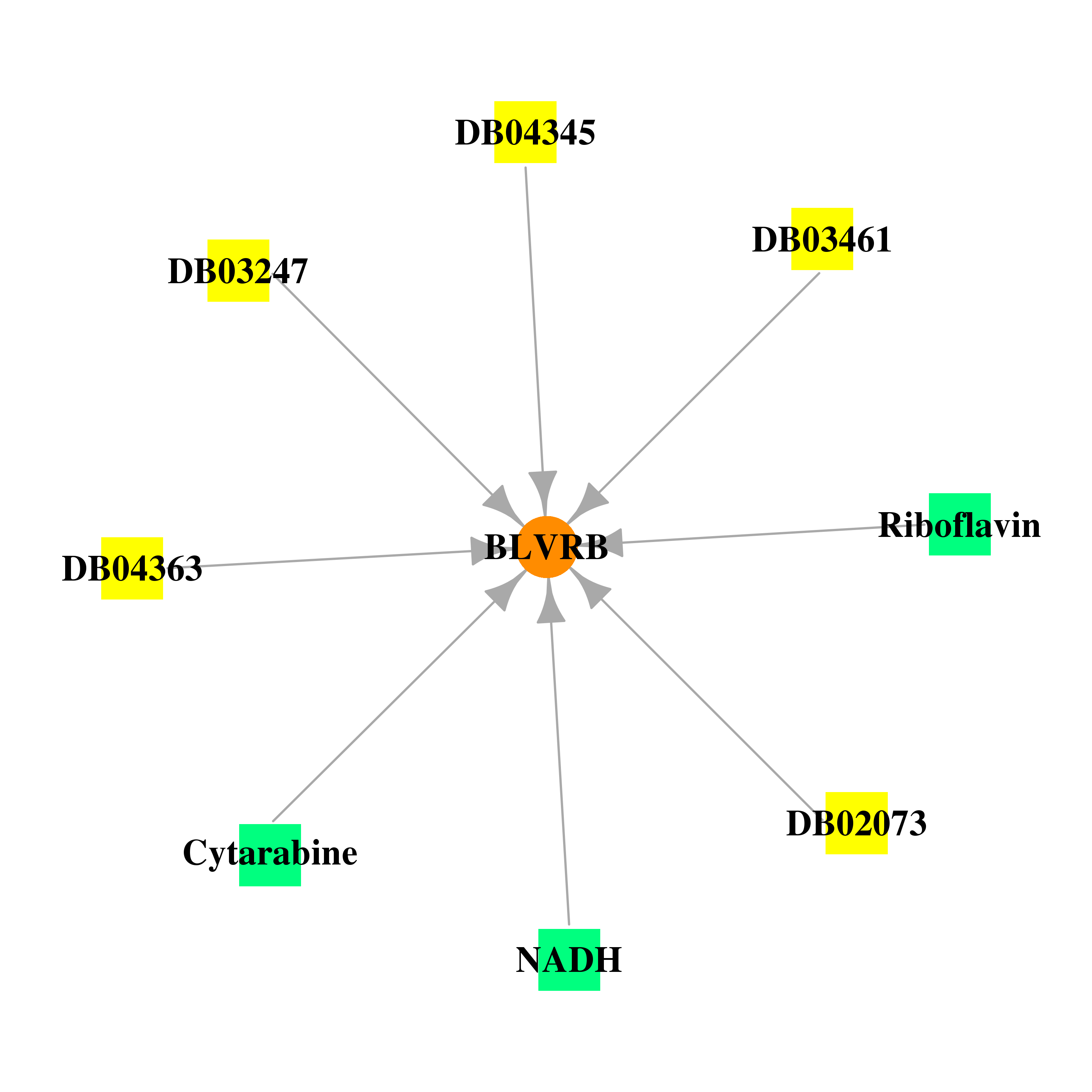 |
| * Drug Centered Interaction Network. |
| DrugBank ID | Target Name | Drug Groups | Generic Name | Drug Centered Network | Drug Structure |
| DB00140 | biliverdin reductase B (flavin reductase (NADPH)) | approved; nutraceutical | Riboflavin |  |  |
| DB00157 | biliverdin reductase B (flavin reductase (NADPH)) | approved; nutraceutical | NADH |  | 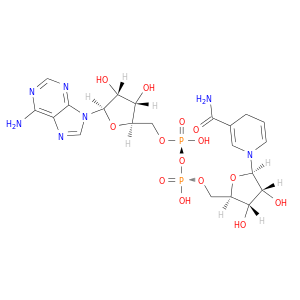 |
| DB02073 | biliverdin reductase B (flavin reductase (NADPH)) | experimental | Biliverdine Ix Alpha |  |  |
| DB03247 | biliverdin reductase B (flavin reductase (NADPH)) | experimental | Riboflavin Monophosphate |  |  |
| DB03461 | biliverdin reductase B (flavin reductase (NADPH)) | experimental | 2'-Monophosphoadenosine 5'-Diphosphoribose | 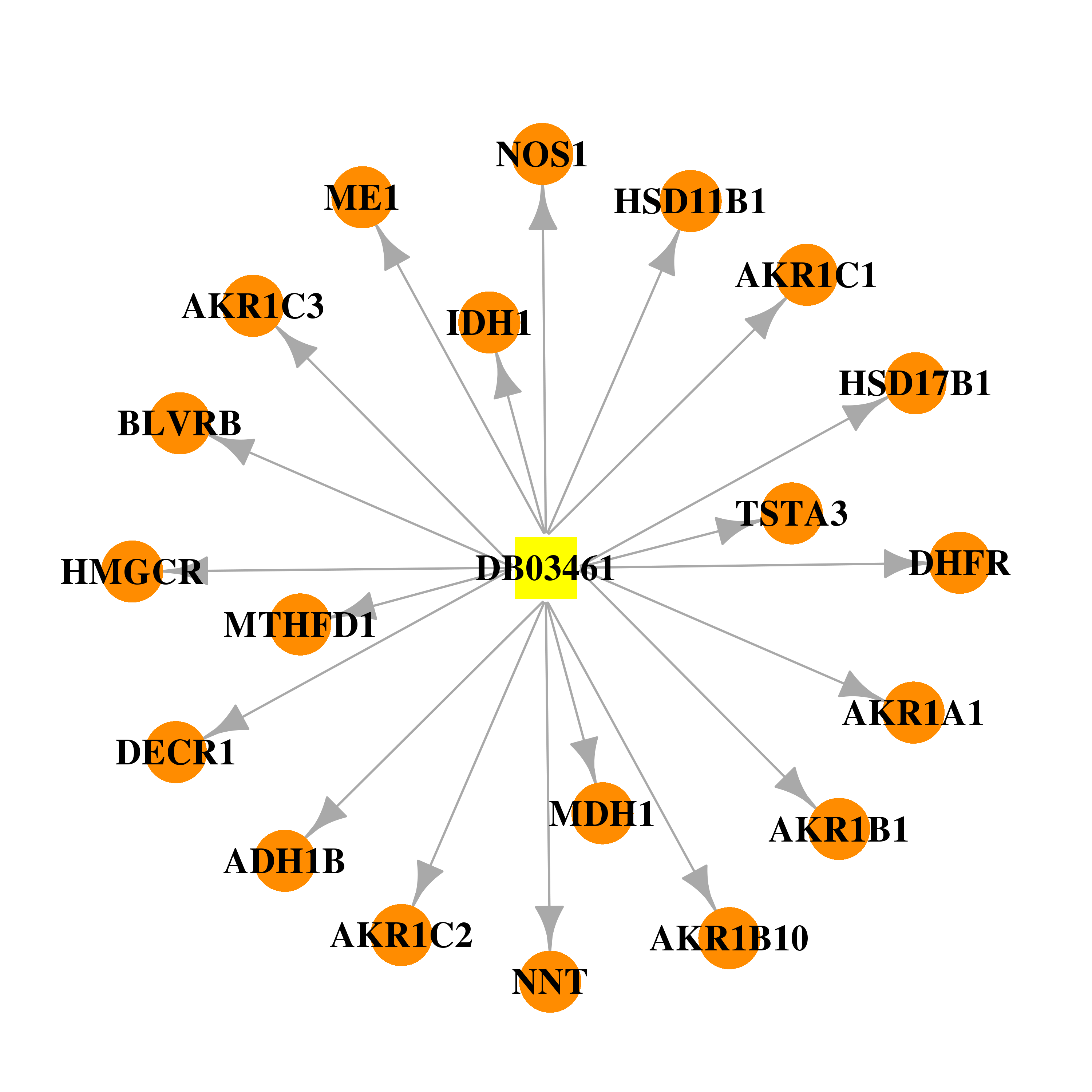 |  |
| DB04345 | biliverdin reductase B (flavin reductase (NADPH)) | experimental | 7,8-dimethylalloxazine |  | 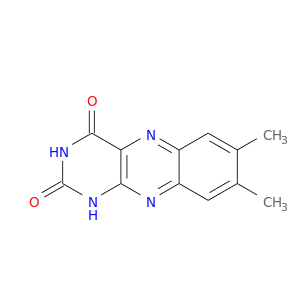 |
| DB04363 | biliverdin reductase B (flavin reductase (NADPH)) | experimental | Mesobiliverdin Iv Alpha | 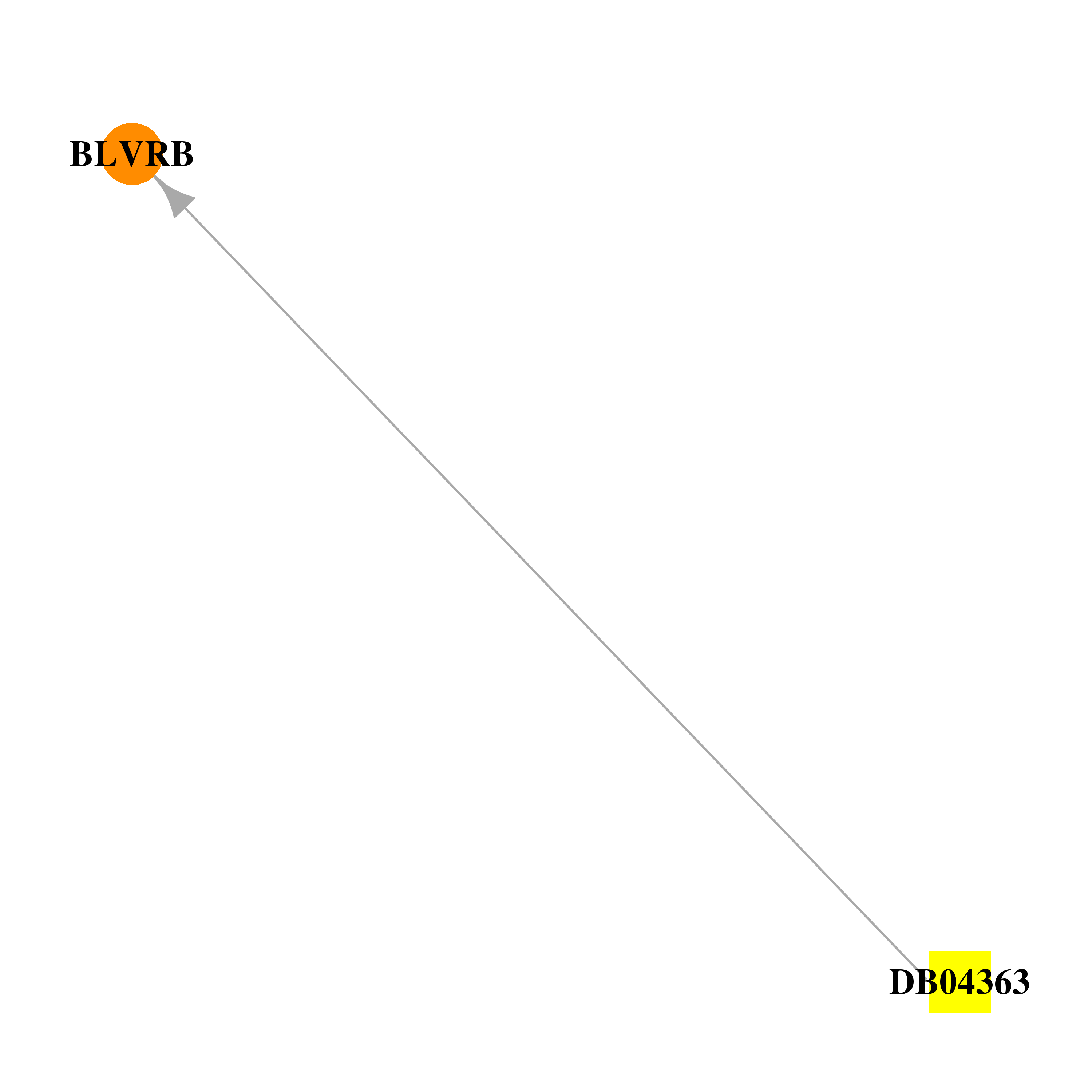 | 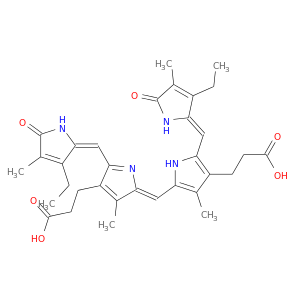 |
| DB00987 | biliverdin reductase B (flavin reductase (NADPH)) | approved; investigational | Cytarabine |  | 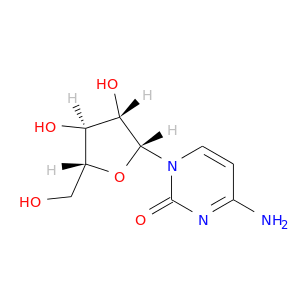 |
| Top |
| Cross referenced IDs for BLVRB |
| * We obtained these cross-references from Uniprot database. It covers 150 different DBs, 18 categories. http://www.uniprot.org/help/cross_references_section |
: Open all cross reference information
|
Copyright © 2016-Present - The Univsersity of Texas Health Science Center at Houston @ |







